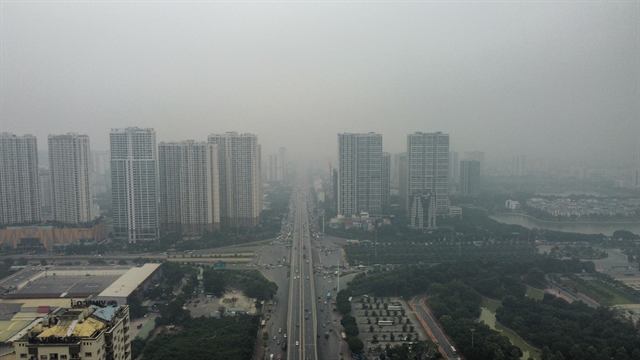Toxic air in Hà Nội slashes incomes, increases health risks
Society – Economy - Ngày đăng : 08:54, 27/11/2024
 |
| In 2024, Hà Nội experienced four significant pollution episodes, occurring primarily between January and April, and again in October. — VNA/VNS Photo |
HÀ NỘI — Fine particulate matter (PM2.5) pollution has consistently exceeded safety standards in Hà Nội and nearby provinces such as Bắc Ninh and Thái Nguyên since 2019.
Data from the Ministry of Natural Resources and Environment's Department of Environmental Pollution Control shows a sustained decline in air quality in key cities, especially Hà Nội, Hải Phòng, Bắc Ninh and Hải Dương.
Between 2022 and 2023, PM2.5 levels in Hà Nội, Bắc Ninh and Thái Nguyên consistently exceeded national standards.
Hà Nội recorded average PM2.5 concentrations ranging from 26 to 52 µg/m³, exceeding permissible limits by 1.1 to 2.1 times.
This year, the city experienced four significant pollution episodes, occurring primarily between January and April and again in October.
Deputy Director of the Department of Environmental Pollution Control, Lê Hoài Nam, said that pollution levels peak from October to March, coinciding with northern region's winter season, which brings weather conditions like low rainfall, calm winds and temperature inversions that prevent the dispersion of fine particles.
Human activities, particularly traffic, industrial production, construction and open burning, further compound the problem.
At a recent conference on air pollution in major urban areas of Việt Nam, Deputy Director of Hà Nội’s Department of Natural Resources and Environment, Nguyễn Minh Tấn, identified fine dust PM2.5 and PM10 as the capital’s most concerning pollutants.
Research links elevated PM2.5 levels to significant health issues, with an annual average of 1,100 hospital admissions for cardiovascular conditions and nearly 3,000 for respiratory diseases.
An increase of 10 µg/m³ in PM10 or PM2.5 levels results in 1.4 and 2.2 per cent more hospitalisations for respiratory ailments in children, Tấn said.
He noted that air pollution from 2011 to 2015 had reduced urban incomes by an estimated 20 per cent.
In response, Hà Nội authorities have prioritised emission reduction, particularly from transportation.
Solutions include developing low-emission zones, increasing street cleaning, addressing traffic congestion and transitioning to eco-friendly public transport.
Other measures include the near-complete elimination of coal stoves, an 80 per cent reduction in straw burning and the closure of hundreds of manual brick kilns.
Over 90 per cent of waste is now collected daily and pilot emissions testing for older motorbikes is underway.
Hà Nội has also committed to a green economic model, aiming to lower carbon emissions, improve residents’ quality of life, and reduce climate-related risks.
These initiatives support Việt Nam’s broader goal of achieving net-zero emissions by 2050.
A call for cooperation
Deputy Chairman of Hà Nội People’s Committee, Nguyễn Trọng Đông, called for collaborative efforts, noting that the city generates significant greenhouse gas emissions from its ten industrial parks, 1,300 craft villages, over seven million motorbikes and more than 600,000 cars.
Daily energy consumption in the city reaches approximately 80 million kWh of electricity and millions of litres of fuel, compounded by the frequent open burning of agricultural and household waste.
"Protecting air quality is a responsibility shared by all," Đông said.
He called for collaboration between neighbouring provinces, central ministries and international partners to address this critical issue effectively.
Minister of Natural Resources and Environment Đỗ Đức Duy described air pollution as a pressing challenge not just for Việt Nam, but globally.
He said that rapid urbanisation and economic development have intensified the problem over the past decade.
"Air pollution transcends administrative boundaries and requires unified responsibility," Duy said, urging for decisive action to enhance air quality and public health while fostering sustainable development. — VNS
